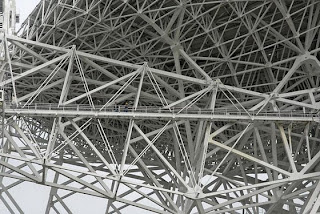The Arecibo Observatory is a radio telescope located close to the city of Arecibo in Puerto Rico. It is operated by Cornell University under cooperative agreement with the National Science Foundation. The observatory works as the National Astronomy and Ionosphere Center (NAIC) although both names are officially used to refer to it. NAIC more properly refers to the organization that runs both the observatory and associated offices at Cornell University.
The observatory's 305 m radio telescope is the largest single-aperture telescope (cf. multiple aperture telescope) ever constructed. It carries out three major areas of research: radio astronomy, aeronomy (using both the 305 m telescope and the observatory's lidar facility), and radar astronomy observations of solar system objects. Usage of the telescope is gained by submitting proposals to the observatory, which are evaluated by an independent board of referees.
The telescope is visually distinctive and has been used in the filming of notable motion picture and television productions: as the villain's antenna in the James Bond movie GoldenEye, as itself in the film Contact, the The X-Files episode "Little Green Men", and the docu-drama Super Comet: After The Impact. The telescope received additional international recognition in 1999 when it began to collect data for the SETI@home project.
Source
 The Robert C. Byrd Green Bank Telescope is the world's largest fully steerable radio telescope. The Green Bank Telescope (GBT) is located at the National Radio Astronomy Observatory's site in Green Bank, Pocahontas County, West Virginia (79° 50' 23.40" W, 38° 25' 59.23" N : NAD83).
The Robert C. Byrd Green Bank Telescope is the world's largest fully steerable radio telescope. The Green Bank Telescope (GBT) is located at the National Radio Astronomy Observatory's site in Green Bank, Pocahontas County, West Virginia (79° 50' 23.40" W, 38° 25' 59.23" N : NAD83).
The GBT is described as a 100-meter telescope, but the actual dimensions of the surface are 100 by 110 meters. The overall structure of the GBT is a wheel-and-track design that allows the telescope to view the entire sky above 5 degrees elevation. The track, 64 m (210 ft) in diameter, is level to within a few thousandths of an inch in order to provide precise pointing of the structure while bearing 7300 metric tons (16,000,000 pounds) of moving weight.
Source
The observatory's 305 m radio telescope is the largest single-aperture telescope (cf. multiple aperture telescope) ever constructed. It carries out three major areas of research: radio astronomy, aeronomy (using both the 305 m telescope and the observatory's lidar facility), and radar astronomy observations of solar system objects. Usage of the telescope is gained by submitting proposals to the observatory, which are evaluated by an independent board of referees.
The telescope is visually distinctive and has been used in the filming of notable motion picture and television productions: as the villain's antenna in the James Bond movie GoldenEye, as itself in the film Contact, the The X-Files episode "Little Green Men", and the docu-drama Super Comet: After The Impact. The telescope received additional international recognition in 1999 when it began to collect data for the SETI@home project.
Source
World's largest fully steerable radio telescope
 The Robert C. Byrd Green Bank Telescope is the world's largest fully steerable radio telescope. The Green Bank Telescope (GBT) is located at the National Radio Astronomy Observatory's site in Green Bank, Pocahontas County, West Virginia (79° 50' 23.40" W, 38° 25' 59.23" N : NAD83).
The Robert C. Byrd Green Bank Telescope is the world's largest fully steerable radio telescope. The Green Bank Telescope (GBT) is located at the National Radio Astronomy Observatory's site in Green Bank, Pocahontas County, West Virginia (79° 50' 23.40" W, 38° 25' 59.23" N : NAD83).The GBT is described as a 100-meter telescope, but the actual dimensions of the surface are 100 by 110 meters. The overall structure of the GBT is a wheel-and-track design that allows the telescope to view the entire sky above 5 degrees elevation. The track, 64 m (210 ft) in diameter, is level to within a few thousandths of an inch in order to provide precise pointing of the structure while bearing 7300 metric tons (16,000,000 pounds) of moving weight.
Source









